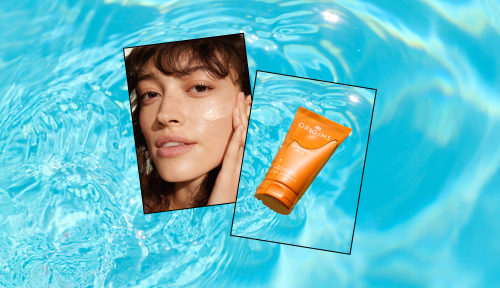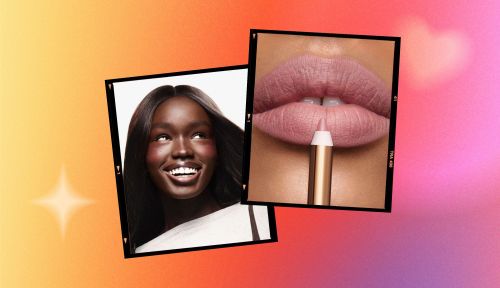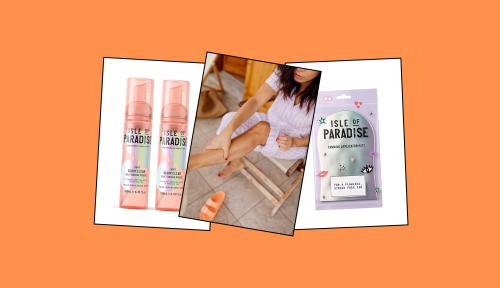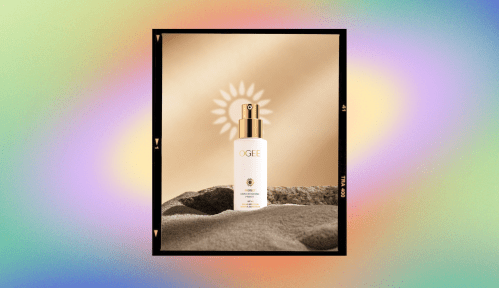Our editors independently select these products. Making a purchase through our links may earn Well+Good a commission
Why You Should *Always* Look for Sunscreens With Iron Oxide if You’re Prone to Hyperpigmentation
The best sunscreens for hyperpigmentation contain iron oxides. That's because iron oxide helps to protect against visible light.

For those of us who get melasma or dark spots from scars and pimples, sunlight is the enemy. It can make the discoloration deeper and more challenging to get rid of—which means using one of the best sunscreens for hyperpigmentation is tantamount.
Experts in This Article
board-certified dermatologist based in New York City
While using SPF, in general, is essential for managing discoloration, certain formulas are better than others for this specific situation. “If you are prone to hyperpigmentation, and especially for those with skin of color, please use a physical sunscreen, particularly one with iron oxide,” says Elizabeth Kream, MD, a dermatologist based in Chicago. Keep reading to find out why.
What is sunscreen and why do you need it?
In simplest terms, sunscreen protects the skin from sun damage by defending against UV light. To understand why this is important, it’s first important to understand what can happen to your skin when it’s exposed to the sun.
The sun emits two different types of UV rays, which each impact your skin differently (though, it’s worth noting that exposure to both can up your risk of skin cancer). First, there are UVA rays, which you can think of as “UV aging” rays. These have longer wavelengths that are able to penetrate the skin more deeply, causing a breakdown of collagen and elastin that contributes to signs of skin aging.
Then, there are UVB rays, which are shorter and only damage the top layer of skin. Not only does this type of sun exposure cause sunburns (think: UV “burning” rays), but it also leads to discoloration. When UVB rays hit the skin, melanocyte cells—which are responsible for creating pigment, known as melanin—kick into overdrive. They send melanin to the surface of the skin to act as your body’s defense mechanism against the sun, and ultimately leave it discolored.
Given all the potential for damage, dermatologists recommend slathering on at least SPF 30 every day (and reapplying regularly) for the sake of keeping skin healthy and protected.
How does sunscreen work?
There are two different types of sunscreen on the market, each of which works in a slightly different way and comes with its own set of benefits.
Chemical
“Chemical sunscreens are made up of chemicals that are absorbed into the skin, where they can absorb the UV rays and create a chemical reaction that changes the UV rays into heat and the heat is then released from the skin,” says New York City board-certified dermatologist Hadley King, MD.
These formulas include active ingredients like avobenzone, octinoxate, octocrylene, or homosalate, and are beloved for their ability to go on totally invisibly. Chemical sunscreens need at least 20 minutes to sink into the skin and work to their full potential, so it’s important to give yourself enough time post-application before you step outside.
Mineral
Mineral, or “physical,” SPF formulas are often referred to as “sunblocks,” because that’s what they do: They physically block out the sun. They’re made with zinc oxide, titanium dioxide, and iron oxide, which sit on top of the skin to deflect and scatter UV rays before they ever have a chance to penetrate the skin and do damage.
Dermatologists recommend mineral sunscreens for those with sensitive skin, as they’re less likely to cause irritation, and for anyone who’s pregnant or breastfeeding. They work immediately, but by nature of the ingredients they’re formulated with, they tend to be thick and leave behind a white or chalky cast.
What are the best sunscreens for melasma and hyperpigmentation?
The derm-approved directive here is simple: “Opt for a physical sunscreen with a tint,” says Dr. Kream. The reason? “The tint typically means that the active ingredient iron oxide is also on board, and this ingredient also provides visible light protection in addition to UV protection. Visible light is what we see—it’s what goes through windows and is a known exacerbator of melasma and photo-aging,” she explains.
A 2020 study1, which tested the efficacy of sunscreens with iron oxide on skin of color, confirms that these formulas should be the top pick for anyone dealing with hyperpigmentation. It found that iron-oxide-containing formulations “significantly protected against visible-light-induced pigmentation compared to untreated skin or mineral SPF 50+ sunscreen in Fitzpatrick IV individuals,” or people with darker skin tones. What’s more, “these results highlight that iron-oxide-containing formulas in a foundation format have dual functions and can provide additional benefits in patients’ daily routine by masking existing pigmentation and preventing the development of pigmentation triggered by sunlight exposure, extending protection beyond the UV spectrum.”
Another study from 20212 found that sunscreens formulated with iron oxides “provide enhanced protection against blue light, especially when combined with zinc oxide,” which means they add another level of defense against photoaging.
In general, mineral sunscreens are a better choice than their chemical counterparts for anyone dealing with melasma or dark spots, because chemical formulas can inadvertently trigger hyperpigmentation. “The mechanism of action of chemical sunscreens is they absorb the solar radiation and transform it into heat. These particles then become excited, and when they revert back to their un-excited ground state, they will release heat onto our skin, and heat is a known trigger of melasma,” says Dr. Kream. “Unlike chemical sunscreens, physical sunscreens don’t absorb UV radiation and dissipate heat; rather they will just reflect the UV radiation.”
Though iron oxide is a mineral blocker, it’s not often used as a stand-alone sunscreen like zinc oxide or titanium dioxide. So while you’ll likely see one (or both) of those listed as active ingredients, iron oxides are often listed in the inactive ingredient section.
Once you’ve got your sunscreen, be sure to apply two fingers worth to your face and neck every two hours for optimal protection. Shop three of our fave sunscreens with iron oxide below.
9 best iron oxide sunscreens for hyperpigmentation
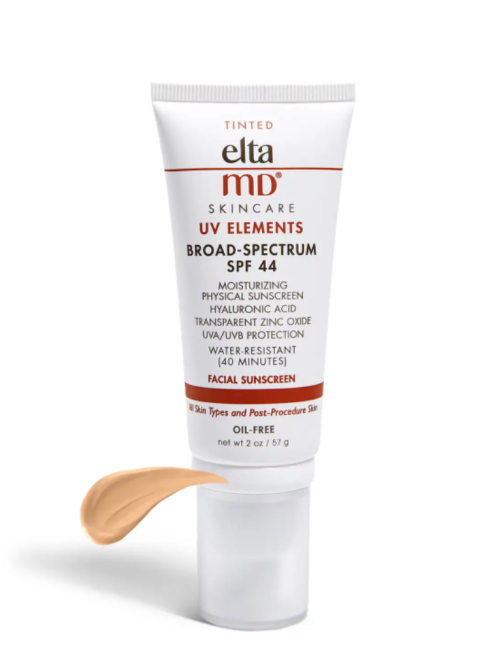
EltaMD, UV Elements Tinted Broad-Spectrum SPF 44 — $39.00
This tinted mineral sunscreen is made with zinc oxide and titanium dioxide to provide broad-spectrum UVA and UVB protection along with iron oxide to protect from visible light. It’s also rich in antioxidants to combat skin-aging free radicals and includes hyaluronic acid to quench and plump dry skin.
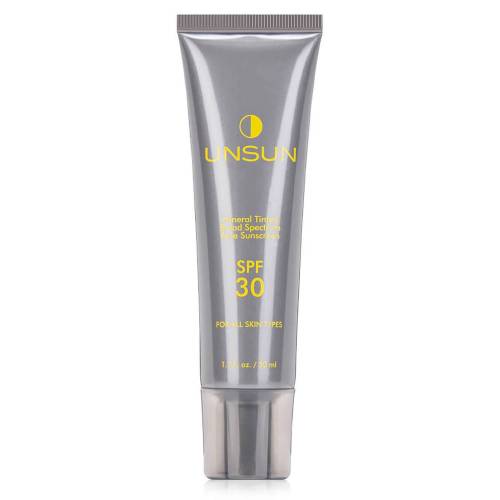
Unsun Cosmetics, Mineral Tinted Broad Spectrum Face Sunscreen SPF 30 — $29.00
Made with zinc oxide, titanium dioxide, and iron oxide, this tinted mineral sunscreen provides SPF 30 protection. It’s available in two shades: medium-dark and light-medium.
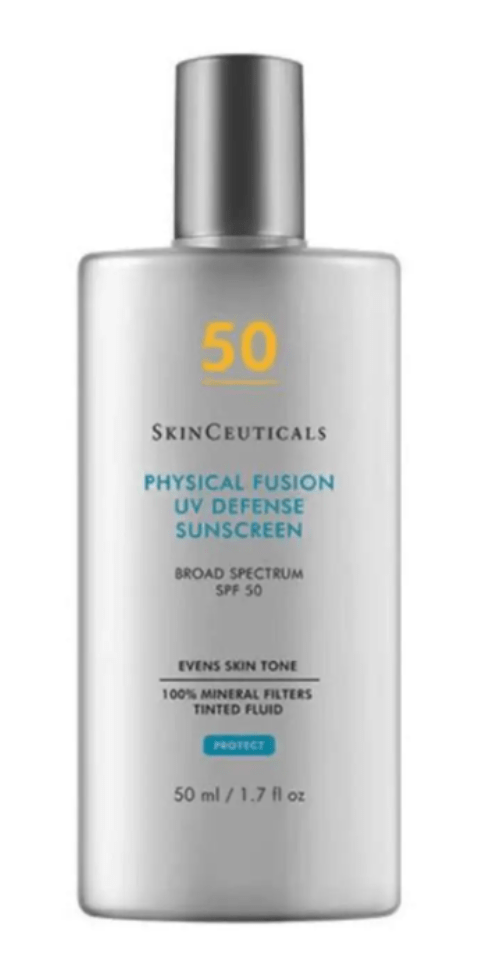
SkinCeuticals, Physical Fusion UV Defense SPF 50 — $36.00
This SPF 50 sunscreen uses zinc oxide, titanium dioxide, and iron oxide to protect skin from UV and visible light while artemia salina, a plankton extract, helps to boost the skin’s natural defenses and resistance to UV- and heat-induced stress.

Tower 28, SunnyDays SPF 30 Tinted Sunscreen Foundation — $32.00
As the first-ever complexion product to be awarded the seal of approval by the National Eczema Foundation, this SPF foundation is a great pick for those with sensitive skin. It offers hefty coverage that will help to mask any discoloration you’re currently dealing with, and comes in 17 blendable shades.

ISDIN, Eryfotona Ageless Ultralight Tinted Mineral Sunscreen SPF 50 — $50.00
If you hate the feeling of applying thick, goopy sunscreen to your face, this is the stuff to you. It’s got a thinned-out texture that feels more like a serum than a lotion or a cream, and feels totally weightless on the skin—if it weren’t for its hyperpigmentation-blurring abilities, you’d never know you had it on at all. The brand has loaded a ton of great anti-aging ingredients into the formula, including DNA “Repairsomes,” which smooth out fine lines and wrinkles and help to repair existing sun damage.

Peter Thomas Roth, Max Mineral Tinted Sunscreen Broad Spectrum SPF 45 — $38.00
This tinted mineral sunscreen offers a double-dose of defense with SPF 45 and vitamin C. The potent antioxidant is beloved for its brightening and skin-tone-evening abilities, making it a great addition to any sunscreen for hyperpigmentation.

Kosas, DreamBeam Silicone-Free Mineral Sunscreen SPF 40 with Ceramides and Peptides — $40.00
If bronzing drops and SPF had a baby, it would be this stunning tinted sunscreen from Kosas. It gives skin a stunning, lit-from-within glow—the fact that it offers sun protection is just an added bonus. It’s also packed with skin-loving ingredients, including plumping peptides, hydrating hylauronic acid, and barrier-strengthening ceramides.
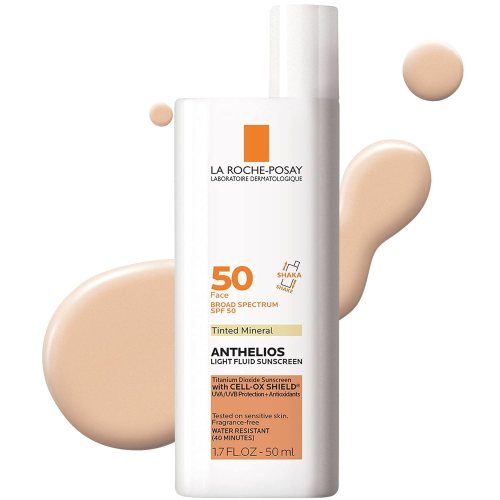
La Roche-Posay, Anthelios Tinted SPF 50 Sunscreen — $38.00
Dermatologists love La Roche-Posay for its sensitive-skin friendly foundation, and this SPF 50 (which you can snag at the drugstore) is a great non-irritating option for anyone dealing with hyperpigmentation. It’s tinted with iron oxide for a little extra sun protection, and also contains niacinamide which is known to help even out skin tone. Preventing hyperpigmentation while also treating what you’ve already got? Well worth the $38.
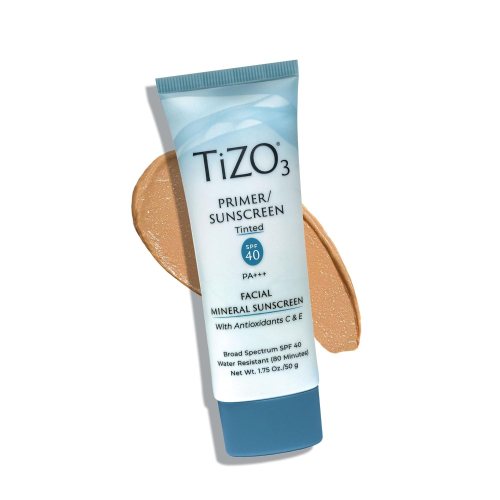
TiZO3, Facial Mineral Sunscreen and Primer
Adeline Kikam, DO, the brain behind @brownskinderm, wears this tinted sunscreen every day, and regularly recommends it to her patients with deeper skin tones. It’s a mineral SPF 40, and is made with antioxidants like vitamins C and E to help fend off sun damage, plus ceramides to help moisturize and strengthen the skin barrier. “It feels really really great on the skin—it’s very light and soft,” says Dr. Kikam. “I like the tinted one, though I’ve heard the non-tinted one is very good too.”

Iris&Romeo, Weekend Skin SPF 50 Instant Glow Tinted Mineral Sunscreen with Vitamin C + Niacinamide — $50.00
Vitamin C, niacinamide, and SPF 50 deliver a triple-threat of discoloration-fighting power to this sunscreen-makeup hybrid (which previously won a W+G award!). It’s got the most gorgeous tinted finish, and offers enough coverage that it very well may replace your favorite foundation. Regularly wearing sunscreen has truly never been easier, mostly because you’ll be genuinely excited to put this one on every morning.
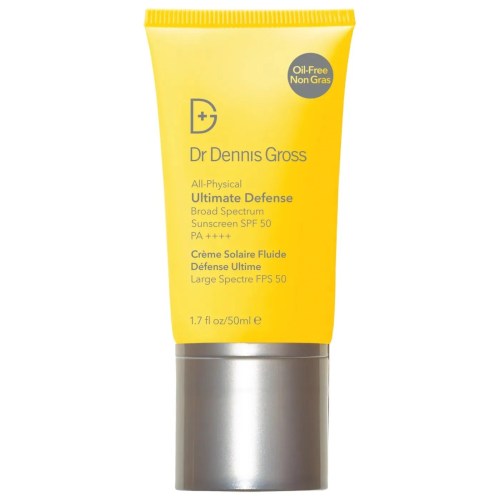
Dr. Dennis Gross, All-Physical Ultimate Defense Broad Spectrum Sunscreen SPF 50 PA++++ — $42.00
If tinted sunscreens simply aren’t your thing, you can still find products that will help you manage hyperpigmentation—they just won’t have iron oxides in them. This one, from Dr. Dennis Gross Skincare, uses tranexamic acid to fade discoloration.
“One of the biggest contributors to hyperpigmentation is sun exposure; by adding tranexamic acid to the ultimate defense SPF, you are not only getting the protective benefits from zinc dioxide, you also have an added layer of protection against hyperpigmentation that may form as a result of sun exposure,” says Dr. Gross. “It works by blocking skin cells and melanocytes—aka the cells that produce pigment—from communicating with each other, leading to a reduction in pigmentation. It helps with everything from sun spots to post-inflammatory hyperpigmentation, and there is even some anecdotal evidence suggesting it helps with melasma.”
People also ask
Can sunscreen cause hyperpigmentation and melasma?
Sunscreen won’t cause discoloration, but sun exposure sure as hell can. Because UV rays stimulate melanin production (which, as you now know, leads to hyperpigmentation), it’s extra important to wear SPF to fend off any damage.
Can sunscreen reverse hyperpigmentation?
Studies have shown that sunscreen can help manage hyperpigmentation without additional lightning agents. According to The American Academy of Dermatology, “Effective treatment for dark spots and patches begins with sunscreen. Whether you’re treating the dark spots on your own or seeing a dermatologist, using sunscreen is essential when you’ll be outside. Applied daily, sunscreen can prevent new dark spots and patches. It can also help to clear existing ones.”
What is best to fade hyperpigmentation?
In addition to regularly wearing a sunscreen that’s tinted with iron oxide, dermatologists recommend adding ingredients like niacinamide, vitamin C, and hydroquinone (which you’ll need a prescription for) to your routine to fade hyperpigmentation.
Can I use sunscreen during pregnancy?
You can, and you should. Just be sure to stick with mineral formulas, which have been giving the pregnancy-safe stamp of approval from dermatologists.
What is the best sunscreen for different skin types?
The best sunscreen, according to dermatologists, is the one you’re going to use every day. Those with sensitive skin or who are prone to discoloration should opt for mineral formulas, as they’re less likely to cause irritation and hyperpigmentation, but everyone else has an endless array of options at their fingertips.
Want to be the first to hear about the latest (and greatest) SHOP product drops, custom collections, discounts, and more? Sign up to have the intel delivered straight to your inbox.
Dumbuya, Hawasatu et al. “Impact of Iron-Oxide Containing Formulations Against Visible Light-Induced Skin Pigmentation in Skin of Color Individuals.” Journal of drugs in dermatology : JDD vol. 19,7 (2020): 712-717. doi:10.36849/JDD.2020.5032
↩︎Bernstein, Eric F et al. “Iron oxides in novel skin care formulations attenuate blue light for enhanced protection against skin damage.” Journal of cosmetic dermatology vol. 20,2 (2021): 532-537. doi:10.1111/jocd.13803
↩︎


